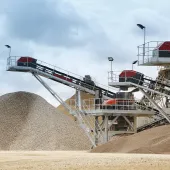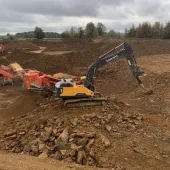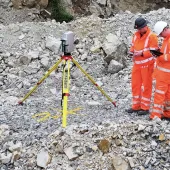Aggregates reserves base still under pressure

Latest MPA AMPS report highlights continued concerns behind diminished aggregate reserves
THE Mineral Products Association (MPA) has published its fifth Annual Mineral Planning Survey (AMPS 2016), which covers the period to the end of 2015. It is based upon data for the whole of Great Britain provided in confidence by MPA members.
The survey has been produced against the background of a continued increase in demand for aggregates across Great Britain during 2015, with crushed rock continuing to dominate sales.
Demand for sand and gravel continues to consistently outstrip new reserves being permitted, with the 10-year average for replenishment of land-won sand and gravel remaining low at 61%. This is despite the sand and gravel reserves consented in 2015 exceeding the annual sales for the first time since the AMPS process commenced in 2004.
In the case of crushed rock, while the 10-year average replenishment rate remains above 100%, the new reserves permitted in 2015 were less than the annual sales for the third consecutive year. Collectively, this suggests that the long-term reserve base upon which the aggregates industry is dependent remains under pressure.
The AMPS data, which shows the interface between mineral operators and the land use planning system, is derived from original MPA data together with information from the annual Aggregate Working Party reports. In the last few years, this work has been compiled in the form of the MPA AMPS reports.
The key findings of the survey are:
- Sales – total sales of land-won sand and gravel and crushed rock in GB by MPA members increased by 3.1% and 5.8%, respectively, in 2015, reflecting continued growth in overall construction and economic activity.
- Replenishment of sand and gravel reserves – for the first time since this survey began in 2004, more sand and gravel reserves were permitted than sold in 2015, with new reserves amounting to 117% of the material sold in that year. The rolling 10-year average for replenishment of land-won sand and gravel reserves remains low at 61%, meaning that sales continue to outstrip the amount of new reserves permitted.
- Replenishment of crushed rock reserves – the equivalent rolling 10-year average for replenishment of crushed rock reserves in 2015 was 115%. This, however, represented a reduction for the third consecutive year, reflecting the fact that, since 2013, the replenishment of new reserves of crushed rock in each year has been less than the annual sales.
- Numbers of planning applications – there has been an increase in submissions for sand and gravel in 2015 (18 sites) compared with 2014 (six sites), predominantly for extensions at existing sites. The number of crushed rock applications has reduced to four compared with eight in 2014.
- Numbers of planning decisions – the number of determinations continue to be relatively low (a total of 20 sites) compared to the heights of 2008/09 (30+ sites).
- Time taken to obtain permission – excluding the plan-making process, it still takes almost three years to secure permission for both sand and gravel and crushed rock reserves, based on a 10-year average. The data for 2015 suggests that sand and gravel determinations in 2015 took 14 months longer than applications determined in 2014. The data also show that the time to issue consents post-committee determination has increased, which may reflect decreasing local planning authority resources and/or increasing information requirements and complexity.
- Numbers of Core Strategies/Development Plans adopted – the 2004 Planning and Compulsory Purchase Act required that full plan coverage be in place within three years, ie by 2007. However, at the beginning of November 2016 only 78 out of 122 (63.9%) English local planning authorities had an adopted Core Strategy/Local Plan, with 18 out of 25 (74%) Welsh local authorities having an adopted Local Development Plan. In terms of development plans in English local authorities, the survey suggests that a significant number of plans are neither in place or planned to be in place. Further analysis will be undertaken during 2017 to quantify this.
- Plan Allocations – half of new permissions continue to be for sites that have not been allocated in mineral plans.
Announcing the publication of AMPS 2016, the MPA’s executive director of Planning and mineral resources, Mark Russell, said: ‘Another year of increased demand for aggregates is clearly good news, however, our report highlights the quantum of new reserves that are being permitted will not be able to support the long-term demands that are likely to be placed on these essential construction materials, particularly sand and gravel.
‘Our survey shows that over the last 10 years more than half of new permissions awarded were for sites that have not yet been allocated in mineral plans, which suggests that the plan-led system is not providing the certainty that it should.’
Commenting on continuing concerns that are apparent from the report, Mr Russell said: ‘Government planning policy requires a ‘steady and adequate supply’ of aggregates to be maintained. However, government’s own 2014 Aggregates Monitoring survey shows there has been a 44% reduction in primary aggregate reserves since 2001 and a 20% reduction since 2005.
‘These timeframes coincide with the 10–15 years that are typically required to bring a new aggregate extraction site into operation – from identifying and securing a site, through to getting it into a local plan, securing a planning permission through the development plan system and finally getting the permission implemented.
‘Given the emerging policy ambitions around the delivery of new housing and infrastructure following the Brexit decision, it is important we find ways to work with government and mineral planners to ensure the Managed Aggregate Supply System provides the confidence and certainty the minerals industry requires to make the long-term development and investment commitments that are needed to secure replacement primary aggregate reserves.
‘The industry generally works well with local mineral planning authorities, but they need to be properly resourced so they have enough capacity and expertise to deliver their functions in a timely and effective manner. At the same time, the minerals industry needs to be prepared to bring forward appropriate proposals and applications.’
A copy of the MPA’s AMPS 2016 report can be downloaded below.









